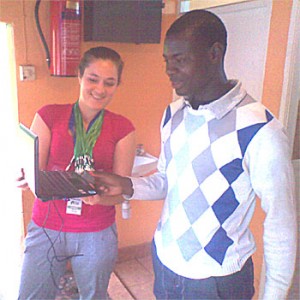The Busara Center
 Behavioral economics has a new testing ground: the Busara Center for Behavioral Economics in Nairobi, Kenya. The lab, which will be open to researchers and students from around the world, is hosted by Innovations for Poverty Action (IPA). Here’s its website blurb:
Behavioral economics has a new testing ground: the Busara Center for Behavioral Economics in Nairobi, Kenya. The lab, which will be open to researchers and students from around the world, is hosted by Innovations for Poverty Action (IPA). Here’s its website blurb:
Busara is a state-of-the-art facility for experimental studies in behavioral economics and other social sciences, located in Nairobi, Kenya. The core of Busara is a pool of participants from the Nairobi slums, combined with a cluster of 20 networked computers with which researchers can investigate economic behavior and preferences. A central feature of the computer setup is that all computers have touchscreen monitors; together with specially developed paradigms, this allows for the participation of not only computer-illiterate, but entirely illiterate populations.
Johannes Haushofer, the Scientific Director of the Center, gave us a little more information:
The lab also includes a 20-person waiting room, 4 individual survey cubicles for private interviews, laboratory space for saliva and blood sampling (a phlebotomist is available), and desk space for visiting researchers and students. The subject pool will reach 1,000 members by the end of May 2012; available demographic information for each subject pool member includes age, ethnicity, education, marital status, number of children, cell phone number, and fingerprint. Participants are invited for studies by SMS; once in the lab, their identity is verified by fingerprint, and after the experiment they are paid through the mobile money system MPesa. The weekly capacity of the lab is 200 participants, and studies are run by a team of 5 full-time staff.
The Center is already running a variety of projects. Ted Miguel, Kjetil Bjorvatn, and Kelly Zhang are working on a project about the “implications of politicized ethnic identity on individual behavior”:
It builds on Ted Miguel’s previous work with Benn Eifert and Dan Posner, which finds that exposure to electoral competition increases the salience of ethnic identity across African countries.
We build on this finding in experimentally varying the salience of ethnic or national identity (through non-confrontational priming) in the run-up to the Kenyan national elections. The goal is to identify how each identity affects individual valuations of public goods and responsiveness to various politician attributes (i.e. ethnicity, education, prior office-holding position, record of public goods provision, promises of jobs, etc.). By conducting multiple rounds of these laboratory experiments in the months before and after the elections, we hope to document how individual behaviors vary within each cross-section, and over time. Our expectation is that the effects of ethnic identity will increase as election time draws near, and that national identity may have the potential to offset politicized ethnic identity.
Our study will be uniquely placed to examine this issue in the context of current Kenyan politics. We are drawing a representative sample from one of the slum areas worst afflicted by the 2007 post-election violence. This population is especially relevant for our study, as they tend to be the ones most targeted by ethnic appeals from politicians. Moreover, in the previous election, there were widespread reports of political mobilization within these communities along ethnic lines. Through this study, we hope to gain better insight as to the potential ramifications of ethnic appeals on the electorate, and to suggest potential ways to ameliorate these politically constructed ethnic divides.
Other interesting projects: an exploration of “the impact of visual information on judgment and decision-making in performance contexts” by Chia-Jung Tsay, a classical pianist and who just completed a Ph.D. from Harvard Business School; and a study by Haushofer on how market mechanisms in competitive markets operate differently in developing countries versus Western markets.
It will be interesting to see what the Busara Center produces, and especially how well it avoids the selection and bias problems that plague many lab experiments.

Comments